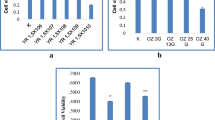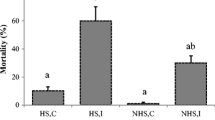Abstract
The present endeavor was conducted to evaluate the role of activated macrophage in the susceptibility of two different rainbow trout (Oncorhynchus mykiss) strains, a susceptible American (T) and a more resistant German (H), to infection with Myxobolus cerebralis. Arginase-2 and inducible nitric oxide synthase (iNOS) genes were used as references to the alternative and classical pathway of macrophage activation. The expression level of both genes was measured using quantitative real-time polymerase chain reaction. The expression level of arginase-2 was significantly upregulated in strain T at 2 h and 8 days post exposure in the strain H. In case of iNOS, the expression level was significantly upregulated from 24 h to 8 days p.e. in strain T and only in 8 days p.e. in strain H. During this study also, the influence of nitric oxide (NO) on the viability of the triactinomyxon spores (TAMs) of M. cerebralis was evaluated using the NO-donor S-nitroso-N-acetyl-penicillamine (SNAP). Rising final concentrations of SNAP from 0.25 to 1 mM at 2, 4, and 24 h resulted in increasing numbers of propidium iodide-positive TAMs detected. The results of this study suggest an inability of strain T to react with an effective immune response against infection with M. cerebralis. Furthermore, the TAMs of M. cerebralis react with significant decrease of viable spores to rising concentration of SNAP and longer incubation, but there is also evidence for some resistance to NO activity.



Similar content being viewed by others
References
Acosta F, de Galarreta CMR, Ellis AE, Diaz R, Gomez V, Padilla D, Real F (2004) Activation of the nitric oxide response in gilthead seabream after experimental infection with Photobacterium damselae subsp piscicida. Fish Shellfish Immunol 16:581–588
Boucher JL, Moali C, Tenu JP (1999) Nitric oxide biosynthesis, nitric oxide synthase inhibitors and arginase competition for l-arginine utilization. Cell Mol Life Sci 55:1015–1028
Bridle AR, Morrison RN, Nowak BF (2006) The expression of immune-regulatory genes in rainbow trout, Oncorhynchus mykiss, during amoebic gill disease (AGD). Fish Shellfish Immunol 20:346–364
Campos-Pérez JJ, Ellis AE, Secombes CJ (2000) Toxicity of nitric oxide and peroxynitrite to bacterial pathogens of fish. Dis Aquat Org 43:109–115
Chang CI, Liao JC, Kuo L (1998) Arginase modulates nitric oxide production in activated macrophages. Am J Physiol 274:H342–H348
Chevassus B, Dorson M (1990) Genetics of resistance to disease in fishes. Aquaculture 85:83–107
Clark IA, Rockett KA (1996) Nitric oxide and parasitic disease. Adv Parasitol 37:1–56
da Silva ER, Castilho TM, Pioker FC, Silva C, Floeter-Winter LM (2002) Genomic organisation and transcription characterisation of the gene encoding Leishmania (Leishmania) amazonensis arginase and its protein structure prediction. Int J Parasitol 32:727–737
Eisenstein TK, Huang D, Meissler JJ, Alramadi B (1994) Macrophage nitric-oxide mediates immunosuppression in infectious inflammation. Immunobiology 191:493–502
El-Matbouli M, Meixner M, Mattes M (2003) Susceptibility of Hofer strain of rainbow trout to Myxobolus cerebralis, Yersinia ruckeri, Tetracapsula bryosalmonae and VHS virus. Field and laboratory studies. 9th Annual Whirling Disease Symposium, p 39–40
Fiorentino DF, Bond MW, Mosmann TR (1989) Two types of mouse T-helper cell. IV. Th2 clones secrete a factor that inhibits cytokine production by Th1 clones. J Exp Med 170:2081–2095
Gilbert MA, Granath WO (2003) Whirling disease of salmonid fish: life cycle, biology, and disease. J Parasitol 89:658–667
Gobert AP, Daulouede S, Lepoivre M, Boucher JL, Bouteille B, Buguet A, Cespuglio R, Veyret B, Vincendeau P (2000) l-arginine availability modulates local nitric oxide production and parasite killing in experimental trypanosomiasis. Infect and Immun 68:4653–4657
Gonzalez SF, Buchmann K, Nielsen ME (2007) Real-time gene expression analysis in carp (Cyprinus carpio L.) skin: inflammatory responses caused by the ectoparasite Ichthyophthirius multifiliis. Fish Shellfish Immunol 22:641–650
Gordon S (2003) Alternative activation of macrophages. Nat Rev Immunol 3:23–35
Griffin BR, Davis EM (1978) Myxosoma-cerebralis—detection of circulating antibodies in infected rainbow trout (Salmo gairdneri). J Fish Res Board Can 35:1186–1190
Hedrick RP, El-Matbouli M, Adkison MA, MacConnell E (1998) Whirling disease: re-emergence among wild trout. Immunol Rev 166:365–376
Hedrick RP, McDowell TS, Gay M, Marty GD, Georgiadis MP, MacConnell E (1999a) Comparative susceptibility of rainbow trout Oncorhynchus mykiss and brown trout Salmo trutta to Myxobolus cerebralis, the cause of salmonid whirling disease. Dis Aquat Org 37:173–183
Hedrick RP, McDowell TS, Mukkatira K, Georgiadis MP, MacConnell E (1999b) Susceptibility of selected inland salmonids to experimentally induced infections with Myxobolus cerebralis, the causative agent of whirling disease. J Aquat Anim Health 11:330–339
Hedrick RP, McDowell TS, Mukkatira K, Georgiadis MP, MacConnell E (2001) Susceptibility of three species of anadromous salmonids to experimentally induced infectious with Myxobolus cerebralis, the causative agent of whirling disease. J Aquat Anim Health 13:43–50
Hedrick RP, McDowell TS, Marty GD, Fosgate GT, Mukkatira K, Myklebust K, El-Matbouli M (2003) Susceptibility of two strains of rainbow trout (one with suspected resistance to whirling disease) to Myxobolus cerebralis infection. Dis Aquat Org 55:37–44
Hofer B (1903) Über die Drehkrankheit der Regenbogenforelle. Allgemeine Fischerei Zeitung 28:7–8
Iniesta V, Carcele J, Molano I, Peixoto PMV, Redondo E, Parra P, Mangas M, Monroy I, Campo ML, Nieto CG, Corraliza I (2005) Arginase I induction during Leishmania major infection mediates the development of disease. Infect Immun 73:6085–6090
Jenkinson CP, Grody WW, Cederbaum SD (1996) Comparative properties of arginases. Comp Biochem Physiol B Biochem Mol Biol 114:107–132
Joerink M, Forlenza M, Ribeiro CMS, de Vries BJ, Savelkoul HFJ, Wiegertjes GF (2006a) Differential macrophage polarization during parasitic infections in common carp (Cyprinus carpio L.). Fish Shellfish Immunol 21:561–571
Joerink M, Savelkoul HFJ, Wiegertjes GF (2006b) Evolutionary conservation of alternative activation of macrophages: structural and functional characterization of arginase 1 and 2 in carp (Cyprinus carpio L.). Mol Immunol 43:1116–1128
Laing KJ, Grabowski PS, Belosevic M, Secombes CJ (1996) A partial sequence for nitric oxide synthase from a goldfish (Carassius auratus) macrophage cell line. Immunol and Cell Biol 74:374–379
Laing KJ, Hardie LJ, Aartsen W, Grabowski PS, Secombes CJ (1999) Expression of an inducible nitric oxide synthase gene in rainbow trout Oncorhynchus mykiss. Dev Comp Immunol 23:71–85
Lee EH, Kim SM, Kwon SR, Kim SK, Nam YK, Kim KH (2004) Comparison of toxic effects of nitric oxide and peroxynitrite on Uronema marinum (Ciliata: Scuticociliatida). Dis Aquat Org 58:255–260
Lindenstrøm T, Secombes CJ, Buchmann K (2004) Expression of immune response genes in rainbow trout skin induced by Gyrodactylus derjavini infections. Vet Immunol Immunopathol 97:137–148
MacConnell E, Vincent ER (2002) The effects of Myxobolus cerebralis on the salmonid host. Whirling Disease: Rev Curr Topics 29:95–107
Mantovani A, Sozzani S, Locati M, Allavena P, Sica A (2002) Macrophage polarization: tumor-associated macrophages as a paradigm for polarized M2 mononuclear phagocytes. Trends Immunol 23:549–555
Mantovani A, Sica A, Sozzani S, Allavena P, Vecchi A, Locati M (2004) The chemokine system in diverse forms of macrophage activation and polarization. Trends Immunol 25:677–686
Markiw ME (1992) Salmonid whirling disease. USFWS, Fish and Wildlife Leaflet 17:1–11
Mills CD, Kincaid K, Alt JM, Heilman MJ, Hill AM (2000) M-1/M-2 macrophages and the Th1/Th2 paradigm. J Immunol 164:6166–6173
Mori M, Gotoh T (2000) Regulation of nitric oxide production by arginine metabolic enzymes. Biochem Biophy Res Commun 275:715–719
Morris SM, Kepka-Lenhart D, Chen LC (1998) Differential regulation of arginases and inducible nitric oxide synthase in murine macrophage cells. Am J Physiol- 275:E740–E747
Nathan C (1992) Nitric-oxide as a secretory product of mammalian-cells. Faseb J 6:3051–3064
Nathan C, Shiloh MU (2000) Reactive oxygen and nitrogen intermediates in the relationship between mammalian hosts and microbial pathogens. Proc Natl Acad Sci USA 97:8841–8848
Nehring RB, Walker PG (1996) Whirling disease in the wild: the new reality in the intermountain West. Fisheries 21:28–30
Neumann NF, Fagan D, Belosevic M (1995) Macrophage activating factor(s) secreted by mitogen stimulated goldfish kidney leukocytes synergize with bacterial lipopolysaccharide to induce nitric oxide production in teleost macrophages. Develop Comp Immunol 19:473–482
Noel W, Raes G, Ghassabeh GH, De Baetselier P, Beschin A (2004) Alternatively activated macrophages during parasite infections. Trends Parasitol 20:126–133
O’Grodnick JJ (1979) Susceptibility of various salmonids to whirling disease (Myxosoma-cerebralis). Trans Am Fish Soc 108:187–190
Ryce EKN, Zale AV, MacConnell E, Nelson M (2005) Effects of fish age versus size on the development of whirling disease in rainbow trout. Dis Aquat Org 63:69–76
Saeij JPJ, Stet RJM, Groeneveld A, Verburg-van Kemenade LBM, van Muiswinkel WB, Wiegertjes GF (2000) Molecular and functional characterization of a fish inducible-type nitric oxide synthase. Immunogenetics 51:339–346
Saeij JPJ, Van Muiswinkel WB, Groeneveld A, Wiegertjes GF (2002) Immune modulation by fish kinetoplastid parasites: a role for nitric oxide. Parasitology 124:77–86
Sandor M, Weinstock JV, Wynn TA (2003) Granulomas in schistosome and mycobacterial infections: a model of local immune responses. Trends Immunol 24:44–52
Sigh J, Lindenstrøm T, Buchmann K (2004) The parasitic ciliate Ichthyophthirius multifiliis induces expression of immune relevant genes in rainbow trout, Oncorhynchus mykiss (Walbaum). J Fish Dis 27:409–417
Tafalla C, Coll J, Secombes CJ (2005) Expression of genes related to the early immune response in rainbow trout (Oncorhynchus mykiss) after viral haemorrhagic septicemia virus (VHSV) infection. Dev Comp Immunol 29:615–626
Tenu JP, Lepoivre M, Moali C, Brollo M, Mansuy D, Boucher JL (1999) Effects of the new arginase inhibitor N omega-hydroxy-nor-l-arginine on NO synthase activity in murine macrophages. Nitric Oxide 3:427–438
Vandesompele J, De Preter K, Pattyn F, Poppe B, Van Roy N, De Paepe A, Speleman F (2002) Accurate normalisation of real-time quantitative RT-PCR data by geometric averaging of multiple internal control genes. Gen Biol Res. doi:0034.0031-0034.0011
Villamil L, Gómez-Léon J, Gómez-Chiarri M (2007) Role of nitric oxide in the defenses of Crassostrea virginica to experimental infection with the protozoan parasite Perkinsus marinus. Dev Comp Immunol 31:968–977
Vincendeau P, Gobert AP, Daulouede S, Moynet D, Mossalayi MD (2003) Arginases in parasitic diseases. Trends Parasitol 19:9–12
Vincent ER (1996) Whirling disease and wild trout: the Montana experience. Fisheries 21:32–33
Wagner EJ, Smith M, Arndt R, Roberts DW (2003) Physical and chemical effects on viability of the Myxobolus cerebralis triactinomyxon. Dis Aquat Org 53:133–142
Wiegertjes GF, Joerink M (2004) Macrophage polarization in the immune response to parasites. Bull Eur Ass Fish Pathol 24:5–10
Wu GY, Morris SM (1998) Arginine metabolism: nitric oxide and beyond. Biochem J 336:1–17
Yu H, Iyer RK, Kern RM, Rodriguez WI, Grody WW, Cederbaum SD (2001) Expression of arginase isozymes in mouse brain. J Neurosci Res 66:406–422
Acknowledgments
This study was carried out in the course of a research project funded by a grant from the Deutsche Forschungsgemeinschaft (DFG, EL-174/3-1). Statistical advice was kindly provided by S. Shirakashi.
Author information
Authors and Affiliations
Corresponding author
Rights and permissions
About this article
Cite this article
Severin, V.I.C., Soliman, H. & El-Matbouli, M. Expression of immune-regulatory genes, arginase-2 and inducible nitric oxide synthase (iNOS), in two rainbow trout (Oncorhynchus mykiss) strains following exposure to Myxobolus cerebralis . Parasitol Res 106, 325–334 (2010). https://doi.org/10.1007/s00436-009-1661-0
Received:
Accepted:
Published:
Issue Date:
DOI: https://doi.org/10.1007/s00436-009-1661-0




